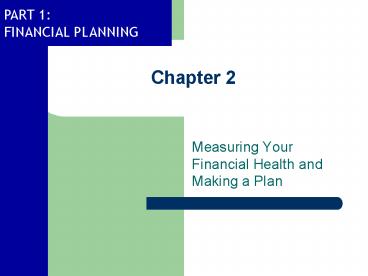Measuring Your Financial Health and Making a Plan - PowerPoint PPT Presentation
1 / 18
Title:
Measuring Your Financial Health and Making a Plan
Description:
Measuring Your Financial Health and Making a Plan Using a Balance Sheet to Measure Your Wealth First Step in a Personal Financial Plan A personal balance sheet is a ... – PowerPoint PPT presentation
Number of Views:89
Avg rating:3.0/5.0
Title: Measuring Your Financial Health and Making a Plan
1
Chapter 2
- Measuring Your Financial Health and Making a Plan
2
Using a Balance Sheet to Measure Your Wealth
- First Step in a Personal Financial Plan
- A personal balance sheet is a statement of your
financial position on a given date. - A snapshot of your financial status at a
particular time. - It lists the assets you own, the debt or
liabilities youve incurred, and your general
level of wealth, known as net worth or equity.
3
Assets What You Own
- All of your possessions are considered assets
even if you owe money on them. - Assets are listed using fair market value.
4
Assets What You Own
- Different types of assets
- Monetary assets liquid assets including cash,
checking and savings accounts, money market funds
- Investments common stocks, mutual funds, bonds
- Retirement plans IRAs, 401(k) or 403 (b)
plans, Keogh plans, SEP-IRA plans, company
pension plans
5
Assets What You Own
- Different types of assets
- House
- Vehicles
- Personal property furniture, jewelry, TVs
- Other collectibles, part ownership in a business
6
Liabilities What You Owe
- Liability is debt that must be repaid in the
future. - Current liabilities must be paid off within the
next year. - Long-term liabilities come due beyond a year.
- List only the unpaid balances.
7
Liabilities What You Owe
- Different types of liabilities
- Current bills unpaid bills including utility
bills, insurance premiums, credit card balances. - Long-term liabilities debt on larger assets
such as home, car, or student loan. - Other loans any other outstanding debt
including installment loans, bank loans.
8
Net Worth A Measureof Your Wealth
- Net worth total assets - total debt
- If liabilities gt assets, then a negative net
worth and insolvency. - If liabilities lt assets, then a positive net
worth. - Manage your net worth so that goals are met in a
timely manner.
9
Using an Income Statementto Trace Your Money
- Second Step in a Personal Financial Plan
- Trace your money.
- Income statement states where your money has come
from and where it has gone over a period of time.
- While the balance sheet was a snapshot, the
income statement is like a movie video. - Personal income statements are on a cash basis,
using actual cash flows.
10
Income Where Your MoneyComes From
- Income or cash inflows
- Wages, salary, bonuses, tips, commissions
- Other sources such as family income, government
payments (veterans benefits, welfare), investment
income. - Some income may be automatically invested for you
towards a retirement plan or insurance plan. - Subtract taxes (federal, state, social security)
from earnings to calculate your take-home pay.
11
Expenditures Where YourMoney Goes
- While income is easy to calculate, spending may
not be. - Cash transactions may not leave a paper trail.
- Classify living expenses as either variable or
fixed expenditures. - The average household in 2005 worked 107 days to
pay taxes 70 days for federal taxes, 37 days
for state and local taxes.
12
Using Ratios Financial Thermometers
- Third Step in a Personal Financial Plan
- Use ratios.
- With financial ratios, you analyze raw data in
the balance sheet or income statement then
compare it to targets. - Use ratios to better understand how you are
managing financial resources.
13
Using Ratios Financial Thermometers
- Use financial ratios to answer these questions
- Do I have enough liquidity to meet emergencies?
- Can I meet debt obligations?
- Am I saving as much as I think I am?
14
Question 1 Do I Have Enough Liquidity to Meet
Emergencies?
- Current ratio monetary assets current
liabilities
- To judge liquidity, compare cash and other liquid
assets with debt. - While financial advisors look for ratio to be
above 2.0, the trend is most important. - This ratio does not consider monthly payments
towards long-term debt (mortgage, car loans).
15
Question 1 Do I Have Enough Liquidity to Meet
Emergencies?
- Months Living Expenses Covered Ratio
monetary assets annual living expenses
- Tells how many months of living expenses can be
covered with present monetary assets. - Liquid assets covering 3-6 months are optimum,
less if credit and insurance protection. - Liquid investments have low risk/low return
trade-off.
16
Question 2 Can I MeetMy Debt Obligations?
- Debt Ratio total debt total assets
- Debt ratio tells you what percentage of your
assets has been financed by borrowing. - This ratio should decrease as you age.
17
Question 2 Can I MeetMy Debt Obligations?
- Long-term Debt Coverage Ratio total
debt total assets
- Relates the amount of funds available for debt
repayment to the size of the debt payments. - This is the number of times you could make your
debt payments with your current income.
18
Question 3 Am I Saving as Much as I Think I Am?
- Savings Ratio
- total debt
- total assets
- This is the ratio of income available for savings
and investment to income available for living
expenses. - It tells you the proportion of your after-tax
income that you are saving.































